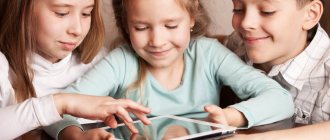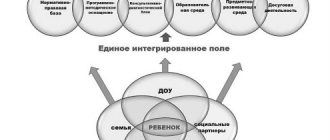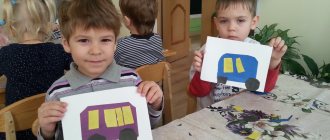System of health work in preschool educational institutions
there are rooms for physical education and music classes, with the necessary equipment;
there are gymnastic benches, sports mats, gymnastic walls, inclined boards, ribbed boards;
stairs for stepping and developing balance, rubber mats, massage mats for the prevention of flat feet, dry pool;
foot massagers, balls, hoops, sandbags, ropes;
skittles, fitballs, hanging targets, soft modules and other necessary equipment. All this allows you to include a large group of children in the work, which ensures high motor density of classes;
there is a touch track, cones for marking;
the sports ground for outdoor exercise is equipped with the necessary equipment, a gymnastic wall and a balance beam;
there is a card index of outdoor games with the necessary hats and other attributes;
there is a large card index for the development of basic types of movement, a card index of physical education minutes and finger games;
in each age group there are physical education corners where children study both independently and under the supervision of teachers;
children of the senior, preparatory groups visit the swimming pool and gym of the children's clinic;
there is a speech therapist's office (logopunkt) for individual correctional work;
a medical office equipped with the following equipment: scales, height meter, spirometer, children’s hand dynamometer, inhaler, bactericidal air irradiator-circulator, plantograph, “Dolphin”, “Solnyshko” devices
The educational process of the preschool educational institution is based on the program “From childhood to adolescence” edited by T.N. Doronova The programs “Fundamentals of the safety of preschool children” by R.B. Sterkina, O.L. Knyazeva, N.N. Avdeeva, “How to raise a healthy child” by V.G. are used. Alyamovskaya.
Having analyzed the program “From Childhood to Adolescence” (section “Physical Education”), the team of teachers came to the conclusion that it does not sufficiently fulfill the children’s need for movement. During the day, the number of movements physiologically necessary for the child is not performed, physical exercises do not solve the problem of training the cardiovascular system, the thermoregulatory apparatus, and therefore do not provide the desired effect in promoting health.
To develop an effective action plan, a system of health-improving work in the preschool educational institution was drawn up, which became a tool for orientation and integration of the efforts of the entire team towards future desired results.
2.2. Children's health monitoring
When organizing health monitoring
children, the medical worker collects information about the child upon admission to kindergarten through a questionnaire, study of documentation and personal conversation.
An important condition for working in this direction is the diagnostic work of a doctor, head nurse, physical education instructor, and educators. They determine the initial functional indicators of the child’s health and the level of his physical fitness. The obtained primary results are a reference for predicting the characteristics of a child’s development, selecting the optimal content of education and upbringing, taking into account the individual characteristics of each child. All this data is recorded in the child's individual card .
After a thorough study of the child’s individual development map, living conditions, behavioral and developmental characteristics, the doctor draws up
a group health passport
(according to E. Borisova), which provides recommendations to educators on how to improve the health of each child individually. Based on group passports, an annual plan for treatment and preventive procedures in preschool educational institutions is drawn up.
Physical education and health activities in preschool educational institutions
Organization of physical education and recreational activities in preschools.
Physical education instructor at MDOU kindergarten No. 32
Kafidov Alexey Vladimirovich
Physical education and health activities are one of the forms of human activity that is aimed at developing a healthy personality. This type of activity is aimed at improving a person’s physical condition and health. Physical education and recreational activities occupy an important place in the field of educational and recreational activities in preschool educational institutions. Physical education and health activities are generally understood as consciously regulated motor activity of a person, aimed at developing and improving one’s own health and caring for it. The effectiveness of physical activity is associated with the formation of motivation for a healthy lifestyle, the acquisition of a certain level of knowledge and, of course, with the implementation of a person’s physical and health-improving activities.
The purpose of physical education and health work in preschool educational institutions is the development of basic motor actions, preparation for physical education at school, disease prevention and health promotion through physical education.
The main objectives of physical education and health work:
- maintaining physical and mental health;
- mastering basic motor actions;
- preparation for physical education at school;
- disease prevention;
- health promotion through physical culture
Physical education and health work in preschool educational institutions includes the following activities:
- physical activity,
- morning exercises,
- gymnastics after a nap,
- physical education minutes,
- games and exercises between classes (dynamic pause),
- outdoor games and exercises while walking,
- hardening activities
Physical education lesson
is the main form of organized educational physical education exercise in preschool educational institutions.
Classes are compulsory for all children. Classes are held all year round. In summer, physical education is not canceled. It is recommended to conduct the following types of physical education classes with preschool children :
Classical classes
(according to the scheme: introductory-preparatory part, main, final parts).
Game activities
(using games: folk outdoor games, relay games, attraction games, etc.).
Training type classes
(walking, running, drills, sports games, climbing exercises, acrobatic elements, ball exercises, etc.).
Story activities
– complex (united with a certain plot, orienteering, with speech development, with quizzes, etc.).
Rhythmic gymnastics
(
classes consisting of dance movements).
Independent training (independent training of your choice, then checking the task by the trainer).
Classes in the “learning your body” series
(talking about your body, learning self-massage, instilling basic self-care and first aid skills).
Thematic classes
(with one type of physical exercise).
Control and testing
classes
(implementation of delays in the development of a child’s motor skills and ways to eliminate them)
Morning exercises
is one of the important components of the motor regime, its organization should be aimed at raising the emotional and muscle tone of children. Daily physical exercise promotes the manifestation of certain volitional efforts, developing a useful habit in children of starting the day with morning exercises. Its purpose and methodology are well known.
A physical education session is being held
by the teacher as necessary (within 3–5 minutes), depending on the type and content of activities on speech development, drawing, and the formation of elementary mathematical concepts, mainly at the moment of signs of fatigue in children. You can conduct a physical education session with musical accompaniment, during which children can perform dance exercises or improvised movements (circling, half-squats, bending, etc.)
Games and exercises between classes
, or motor warm-up, allows you to actively relax after mental stress and forced posture. It consists of 3-4 exercises, as well as voluntary movements of children using a variety of physical education aids. At the end of the warm-up, it is rational to do a relaxation exercise for 1–2 minutes. Long warm-up no more than 10 minutes.
Outdoor games and physical exercises are carried out
on a walk. Outdoor games are complex motor, emotionally charged activities, determined by established rules that help to identify the final outcome or quantitative result. Outdoor games serve as a method of improving motor skills already mastered by children and developing physical qualities. Outdoor games are divided by content into outdoor games with rules and sports games.
Summer fun on walks
. In the summer, entertainment helps the teacher solve serious educational, educational and health problems in an accessible and interesting way. Active participation in entertainment enriches children with new experiences and provides an opportunity to acquire motor skills and abilities. Fun games are essentially physical exercises, put into a game form with or without musical accompaniment (classics, rubber bands)
After a nap, it is important to improve the mood and muscle tone of each child, as well as take care of the prevention of posture and foot problems. This can be facilitated by a complex
of gymnastics after daytime sleep,
which is variable in nature; depending on this, its duration will also change (from 7–15 minutes). Warm-up in bed and a set of exercises.
Hardening
– the most important part of the physical education of preschool children. The best means of hardening are the natural forces of nature: air, sun and water.
To implement the above-mentioned physical education and health activities in preschool institutions, certain conditions are created that contribute to the protection and strengthening of children’s health, their physical and mental development. In addition, traditional forms and methods of health-improving, therapeutic and preventive work with children are used.
To organize physical education and recreational work, the preschool educational institution has: a gym equipped with modern equipment; outdoor sports ground; physical education corners in all age groups; medical and treatment rooms; speech therapy room.
Medical care for preschool children is most often provided by: a doctor, a nurse. During the school year, health-improving work with children is carried out: hardening, preventive vaccinations, fortified nutrition, and regular examinations of children are organized. Throughout the year, parents of pupils are informed about medical and health work and about the morbidity of their children.
When organizing recreational activities, it is necessary to comply with a system for ensuring safe life activities, which involves studying traffic rules and safety precautions in classes and in joint activities.
At the preschool educational institution, targeted work is carried out with the parents of pupils, since only in close contact between teachers and parents can good results be achieved, strengthen and preserve the health of the child
Work on improving the health of children in preschool educational institutions may also include the work of a psychologist in developing communication skills and correcting problems of the child’s emotional development (fears, anxiety, aggressiveness).
Thus, physical education and health work in preschool educational institutions is aimed at and contributes to maintaining physical and mental health and strengthening the child’s body. The choice of specific means and methods depends on the population of children and the tasks of the preschool institution.
Pedagogical conditions for organizing physical education and recreational work in a preschool educational institution
- increasing the professional competence of teachers in the field of physical education of preschool children,
- developing parents’ interest in physical education and health activities in a preschool educational institution,
- implementation of an individually differentiated approach in working with children.
Bibliography
- 19. Khukhlaeva D.V. Theory and methodology of physical education in preschool institutions. M., - 1978.
- Alyamovskaya V.G. How to raise a healthy child. -M.: “Linka-press”, 1993
- Weiner M.E. Game technologies for correcting the behavior of preschool children. Tutorial. – M.: Pedagogical Society of Russia, 2004. – 96 p.
- Gavryuchina L.V. Health-saving technologies in preschool educational institutions: Methodological manual. – M.: TC Sfera, 2007. – 160 p. (Healthy baby)
- Glazyrina L.D. Physical education - for preschoolers M. VLADOS 1999
- Kudryavtsev V.T., Egorov B.B. Developmental pedagogy of health improvement. –M.: “Linka-press”, 2000
- Makhaneva M.D. Raising a healthy child: A manual for practitioners of preschool educational institutions. – M.:2000
- Overchuk T.I. “Health and physical development of children in preschool educational institutions: problems and ways of optimization” - M.: GNOM Publishing House and D., 2002.
- Runova M.A. “Motor activity of a child in kindergarten” - M.: Mozaika-Sintez, 2002.
- Sivtsova A.M. Health-saving pedagogical technologies in preschool educational institutions: selection, implementation and rational use: Methodological recommendations. – St. Petersburg: SPbAPPO, 2008. – 56 p.
- Fomina N.A., Gorina E.A. Musical and rhythmic breathing exercises for preschoolers
- Shebeko V.I., Ermak N.N. Let's play exercises: Creativity in motor activity of children: Pos. for teachers of preschool institutions - Mn.: NM Center, 1999.
- Yakovleva L.V., Yudina R.A. Physical development and health of children 3-7 years old part 1-3 M. VLADOS 2003.
6
“Organization of recreational activities during the day of kindergarten”
CONSULTATION
"Organization of recreational activities
in the daily routine of kindergarten"
Health is not only the absence of disease or physical defects, but also the complete physical, mental and social well-being of a person.
Health activities in kindergarten allow the child to cope with the difficulties of getting used to a new environment, allow them to organize the child’s life in a preschool institution in such a way that leads to the most adequate, almost painless adaptation to new conditions, and the formation of a positive attitude towards all types of everyday life. Children develop various skills that correspond to their age, and the need to communicate with adults is formed. Activities ensure the solution of educational problems already during the period of the child’s adaptation to new conditions and thereby accelerate and facilitate the course of the adaptation period, that is, the child’s adaptation to kindergarten, to public preschool education.
Wellness activities take an integrated approach and are built on three main areas:
Creation of a healthy environment for the prevention of various deviations in psychophysical development in children (vision, flat feet, poor posture, articulation apparatus, breathing). Formation of a healthy lifestyle for children in kindergarten and at home. Development of physical culture.
And also built on the fundamental principles:
- complexity; differentiation; sequences; axiological.
The deterioration of children's health dictates the need to develop and implement health-improving measures aimed at improving children's health and reducing their morbidity. The system of health-improving measures is reflected in the content of health-improving work with preschool children:
I.
Physical development:
Morning exercises for the general development of the child - carried out daily in the morning. Physical education and health classes – 2 times a week. Active and dynamic games - every day during the day. Exercises at the sports complex. Preventive gymnastics – every day after sleep. Breathing exercises after sleep. Gymnastics to improve posture. Gymnastics for the prevention of flat feet. Gymnastics for the speech analyzer. Gymnastics for fine motor skills of the hands.
II.
Ensuring a healthy rhythm of life in kindergarten:
Gentle mode - during the adaptation period Flexible mode - daily.
III.
Hygiene and water procedures:
Washing with hand washing - daily. Games with water – once a week. Compliance with the drinking regime - daily. Quartzization.
IV.
Use of the natural environment for hardening activities:
Ventilation of premises - daily throughout the year. Sleeping with the transom open - every day in the summer. Walks in the fresh air - in winter t not lower than 20° - garden groups, not lower than 15° - nurseries; in summer - daily, 2 times a day. Ensuring temperature conditions and air purity.
V.
Light therapy and color therapy: provision of light regime - color and light accompaniment of the educational process.
VI.
Music therapy: musical accompaniment of rhythmic exercises - daily.
VII.
Hardening:
Barefoot - in summer. Salt hardening - daily after nap. Rinse your mouth daily. Reasonable clothing.
VIII.
Daytime nap, during which the presence of a teacher or his assistant in the bedroom is mandatory.
IX.
Balanced 4 meals a day.
X.
Fortification, including multivitamins and “C” fortification in the third course.
XI.
Timely sanitation of chronic foci of infection.
XII.
Prevention of scoliosis, postural disorders: control over the child’s body position during the day, during classes, during sleep, during meals.
XIII.
Working with parents:
Health Corner. Consultations. Parent meetings.
Salt hardening technique
Indications:
The salt hardening method is indicated for all preschool children.
Technique:
hardening is carried out after daytime sleep under the supervision of a teacher. The child walks barefoot on a flannel mat moistened with a 10% solution of table salt at room temperature. They stomp on the mat for 2 minutes. Children then move to the second mat, wiping the salt off the soles of their feet, and then move to a dry mat and wipe their feet dry. An important point when carrying out hardening is that the foot must be preheated. For this purpose, foot massagers, button and stick paths are used.
Mechanism of action:
mechanical and chemical through thermoreceptors of the skin of the feet. The saline solution irritates the chemoreceptors, causing dilation of the peripheral vessels of the feet. Heat generation reflexively increases and heat is retained. Mechanical actions arise as a result of irritation of biological points on the sole.
Equipment:
3 flannel rugs
A) with different-sized sewn buttons;
B) with sewn sticks.
10% solution of table salt at a temperature of +10°,18°C (1 kg of salt per 10 liters of water: 0.5 kg per 5 liters of water).
This hardening method is accessible and simple, does not require large material costs and time, and is enjoyable for children. And most importantly, it has a pronounced effect and plays a significant role in the prevention of colds in children.
Get text



